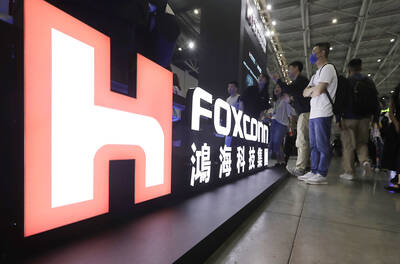An influential electronics group yesterday said it has urged Intel Corp to continue its full support for the development of WiMAX technology it initiated to compete with other 4G technologies, after the US chip giant’s decision to dissolve a WiMAX task force rattled its local partners.
Being long-time followers, Taiwanese electronics companies hope WiMAX technology will give them a chance to dominate the evolving mobile Internet industry, which would also be a boon to telecom-makers and end product suppliers.
“We cannot do it alone. We’ve got to team up with technological partners to make this work,” said Mike Lin (林智清), a consultant to the Taipei Computer Association (TCA, 台北市電腦公會), by telephone.
The TCA fears Intel’s move to incorporate its WiMAX Program Office with other divisions was a message that it was phasing out the development of this technological ecosystem, Lin said.
The TCA, which represents over 4,000 local technology companies including WiMAX equipment makers D-Link Corp (友訊) and Gemtek Technology Co Ltd (正文), said its members were seriously concerned about Intel’s latest structural adjustment involving the WiMAX Program Office.
In a July 7 meeting with Navin Shenoy, a vice president of Intel’s sales and marketing group in the Asia-Pacific region, TCA chairman Wang Jeng-tang (王振堂) said that WiMAX would at least become a niche market if not one of the mainstream technologies and that it was now facing a crucial period.
“If Intel truly wants to see that, it should take Taiwan as a global strategic partner and allocate more resources to Taiwan by collaborating with Taiwanese companies in the WiMAX supply chain,” Wang said in a statement released by the TCA yesterday.
Intel chief executive officer Paul Otellini is expected to talk more about its WiMAX plan during his visit to Taiwan in October, the association said.
Intel confirmed on July 1 a report that it was integrating its WiMAX Program Office with various platform, product and sales organizations.
The progress of WiMAX had led to this organizational transition, a normal process that takes place when new technologies mature and become a standard part of existing computing platforms, the chipmaker said.
This structural change could jeopardize the confidence of Intel’s partners, who fear the US chipmaker might not fulfill its commitment to support WiMAX technology according to the memorandums of understanding it signed with the government and local firms, the TCA said.
“Intel’s decision to dissolve the WiMAX Program Office will scarcely have any impact on the race between WiMAX and LTE [Long Term Evolution] technologies [for 4G dominance] in the short run. But it is likely that fewer countries or areas will adopt WiMAX in the future,” Simon Su (蘇晟愷), an analyst with Digitimes’ research unit, said in a report yesterday.
The weaker-than-expected strength of WiMAX technology in vying for 4G dominance could be one of the reasons behind Intel’s streamlining of its WiMAX office, Su said.

A proposed 100 percent tariff on chip imports announced by US President Donald Trump could shift more of Taiwan’s semiconductor production overseas, a Taiwan Institute of Economic Research (TIER) researcher said yesterday. Trump’s tariff policy will accelerate the global semiconductor industry’s pace to establish roots in the US, leading to higher supply chain costs and ultimately raising prices of consumer electronics and creating uncertainty for future market demand, Arisa Liu (劉佩真) at the institute’s Taiwan Industry Economics Database said in a telephone interview. Trump’s move signals his intention to "restore the glory of the US semiconductor industry," Liu noted, saying that

On Ireland’s blustery western seaboard, researchers are gleefully flying giant kites — not for fun, but in the hope of generating renewable electricity and sparking a “revolution” in wind energy. “We use a kite to capture the wind and a generator at the bottom of it that captures the power,” said Padraic Doherty of Kitepower, the Dutch firm behind the venture. At its test site in operation since September 2023 near the small town of Bangor Erris, the team transports the vast 60-square-meter kite from a hangar across the lunar-like bogland to a generator. The kite is then attached by a

Foxconn Technology Co (鴻準精密), a metal casing supplier owned by Hon Hai Precision Industry Co (鴻海精密), yesterday announced plans to invest US$1 billion in the US over the next decade as part of its business transformation strategy. The Apple Inc supplier said in a statement that its board approved the investment on Thursday, as part of a transformation strategy focused on precision mold development, smart manufacturing, robotics and advanced automation. The strategy would have a strong emphasis on artificial intelligence (AI), the company added. The company said it aims to build a flexible, intelligent production ecosystem to boost competitiveness and sustainability. Foxconn

STILL UNCLEAR: Several aspects of the policy still need to be clarified, such as whether the exemptions would expand to related products, PwC Taiwan warned The TAIEX surged yesterday, led by gains in Taiwan Semiconductor Manufacturing Co (TSMC, 台積電), after US President Donald Trump announced a sweeping 100 percent tariff on imported semiconductors — while exempting companies operating or building plants in the US, which includes TSMC. The benchmark index jumped 556.41 points, or 2.37 percent, to close at 24,003.77, breaching the 24,000-point level and hitting its highest close this year, Taiwan Stock Exchange (TWSE) data showed. TSMC rose NT$55, or 4.89 percent, to close at a record NT$1,180, as the company is already investing heavily in a multibillion-dollar plant in Arizona that led investors to assume